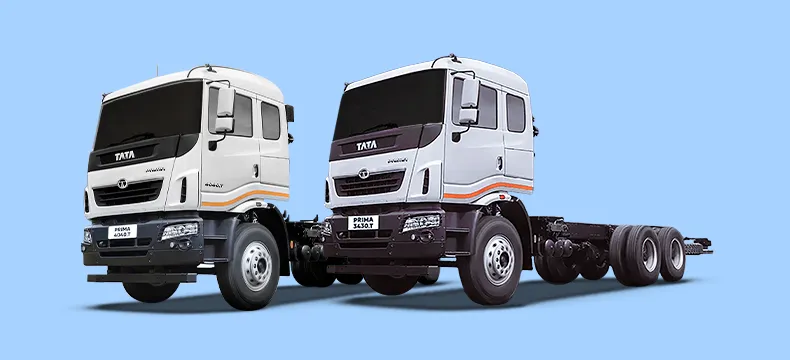5 Dec 2025

Why Do You Need Tyre Balancing?
- Tata Motors
- 13 May 2025
- COMMERCIAL VEHICLE
Introduction
5% of traffic deaths in the UAE are attributed to tyre-related issues. This shows the significance of maintaining this often-overlooked aspect of your vehicle. As a business owner, prioritising tyre balancing ensures your commercial vehicles have even weight distribution around the wheel. As a result, you can prevent wear and tear, which can result in mishaps and losses during critical operations. Read along to learn more about the importance of tyre balancing.
What is Tyre Balancing?
Tyre balancing is a process of equalising the weight distribution of the tyres to ensure a smooth ride. Although all the tyres in a vehicle seem similar in size, shape, and weight, they can differ. Over time, due to regular wear and tear, they may develop slight weight variations in the rim or the overall tyre. Such an unbalanced state causes vibrations and stress to the suspension components. Hence, with tyre balancing, such variation is corrected with small weights to help the tyres rotate smoothly at all speeds.
How Does Tyre Balancing Work?
Tyre balancing is a procedure carried out with a specialised balancing machine. Here's how the process works:
- The wheel and tyre unit are placed on the balancing machine that stimulates real-world driving conditions.
- The machine spins at varying speeds to mimic the driving motion. This helps detect any imbalances in the tyre.
- The machine is also equipped with sensors that pinpoint areas which require additional weight.
- Small counterweights are attached to the wheel rim to correct the detected imbalances.
- Lastly, the wheel is spun again to check if the proper balance is restored before readjusting it to the vehicle.
Tyre Balancing vs. Wheel Alignment – What's the Difference?
From the sound of it, tyre balancing, and wheel alignment seem like interchangeable terms. However, they differ based on the purposes they serve.
Tyre Balancing focuses on evening out the weight distribution within the tyre-wheel assembly. It aims to prevent vibrations and uneven wear by correcting the weight of the tyre.
Wheel alignment is more about adjusting the angles of the wheels to make them perpendicular to the road and parallel to each other. It focuses on the vehicle's suspension to improve handling.
Both wheel alignment and balancing are essential for vehicle maintenance. While tyre balancing deals with vibration issues, wheel alignment ensures proper steering and stability.
Why Do You Need Tyre Balancing?
You can achieve the following benefits of tyre balancing that can boost the performance of your commercial vehicle for greater productivity:
-
Smooth Ride
Unbalanced tyres cause noticeable vibrations, especially at higher speeds. You can feel them in the steering wheel, the floor of the vehicle, or even the seats. Proper tyre balancing eliminates them and leads to a smooth ride.
-
Extended Tyre Life
With even tyre weight distribution, irregular tread wear caused by more pressures in certain areas becomes a problem. Tyre balancing prevents this and prolongs the lifespan of tyres.
-
Boost in Fuel Efficiency
Balanced tyres reduce rolling resistance, which means the engine doesn't have to work harder to keep the vehicle moving. This, in turn, enhances fuel economy.
-
Improved Safety
Unbalanced tyres can impact your vehicle's stability and braking, which can increase the risk of accidents. Balancing the tyres helps maintain optimum control to prevent such scenarios.
-
Lower Impact on Suspensions
Proper tyre balance reduces the strain on the suspension system. As a result, there is a lower possibility of shocks, struts, and wheel bearings. Consequently, costly repairs are prevented.
Signs That it's Time to Consider Tyre Balancing
Look for these signs to identify the need for tyre balancing at the earliest and prevent further issues:
-
Steering Wheel Vibrations
If you notice your steering wheel shaking, especially at higher speeds, it is a strong indication of an imbalance in tyres. It also leads to noticeable vibrations.
-
Uneven Tread Wear
If you find that one part of your tyre's surface is wearing down faster than the rest, it indicates improper weight distribution. This can compromise traction and reduce the lifespan of tyres.
-
Abnormal Fuel Consumption
If your fuel efficiency drops suddenly, unbalanced tyres may be the culprit. As they create higher rolling resistance, the extra effort increases fuel consumption.
-
Vehicle Veering to One Side
Unbalanced tyres cause instability, which makes one side of the vehicle heavier than the other. The same can happen due to wheel misalignment as well. Nonetheless, it is a cause for concern.
-
Strange Noises
A humming or whining noise from your tyres can result from unbalanced tyres putting stress on wheel bearings. If you notice a frequency of such noises, it is better to get the tyres checked.
Conclusion
Checking for signs of uneven weight distribution in tyres and understanding the importance of tyre balancing is crucial to maintaining your vehicle in smooth condition. It prevents unnecessary wear on your vehicle's components and reduces unnecessary operational costs. This is especially true in the Middle East, where road conditions and climate can accelerate tyre wear.
FAQs
What happens if I don't balance my vehicle's tyres?
If you don't balance your vehicle's tyres, you might start to have to deal with issues such as vibrations, uneven tyre wear, and reduced lifespan of your tyres.
Can I balance the tyres myself?
While there are some DIY methods, it's preferable to have a professional balance on your vehicle's tyres, especially for larger trucks. They use specialised machines that get the job done accurately.
How long does the tyre balancing service take?
The process of tyre balancing can typically take about 30 minutes to an hour. It depends on the service provider and the number of tyres being balanced.
Does a new tyre need balancing?
Yes, even brand-new tyres can have balancing issues. Although they are freshly made, slight weight imbalances can occur sometimes during manufacturing or installation.
- Tags
Latest Blogs


4 Dec 2025
Tanker Trucks: Types, Capacity, and Safety

4 Dec 2025


















